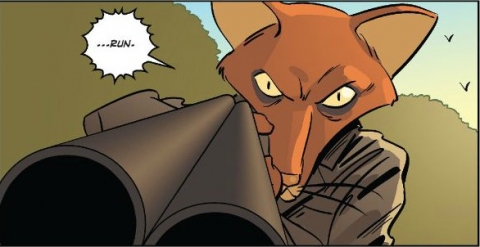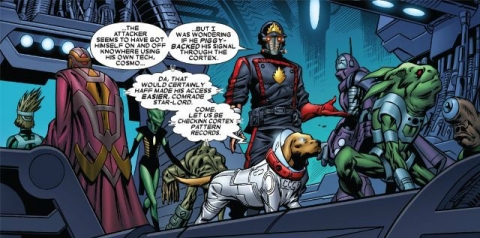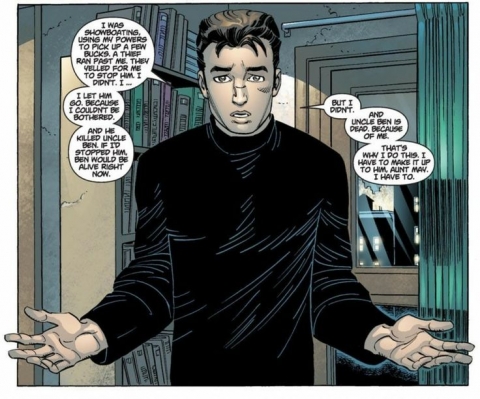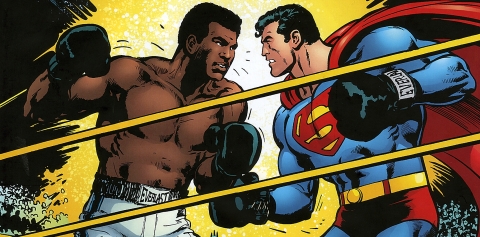52 weeks. 52 different writers. 2 trade paperbacks or hardcovers a week. Each week I’ll take a look at a different writer and read two different collected editions from within that person’s repertoire to help in the examination of their work.
Dan Abnett is yet another wildly imaginative comic writer from the UK, finding success with the title 2000 AD, which resulted in a plethora of doors being opened to other publishers. Working with Marvel, Marvel UK, and DC Comics from the 1990’s onwards, Abnett has produced more comics than you can probably wrap your head around. He is also an accomplished novelist, working for Game Workshop’s Black Library to produce Warhammer books, as well as releasing his first series of original fiction novels through Angry Robot Books back in 2009.
Wild’s End Vol 1: First Light
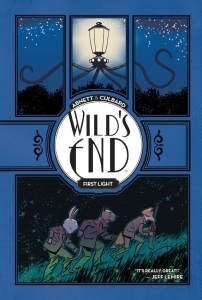 Set in the small English community of Lower Crowchurch in the 1930’s, Wild’s End follows the adventures of this community’s citizens as they try to survive a peculiar alien invasion. When a mysterious light crashes into the ground and promptly burns Fawkes’ best friend to death, Fawkes races into town looking for help from whoever will listen. Labelled as a mischievous drunk, Fawkes is shooed away by the town’s folk with no help or insight. It’s not until Lower Crowchurch’s newest citizen, Clive Slipaway, intervenes and decides to go searching for Fawkes that others begin to take interest. With the town’s solicitor, Gilbert Arrant, and local journalist, Peter Minks, in tow, Clive sets out to search for Fawkes before quickly stumbling upon what he surmises to be an alien invasion from small, oddly shaped saucers and lamp post like beings who torch the Earth around them. Assembling other members of the English countryside, Clive and his unlikely allies fight for not only their own survival but for that of Lower Crowchurch as well, as they frantically try to lead the invaders away from the town while trying to figure out a way to stop them entirely.
Set in the small English community of Lower Crowchurch in the 1930’s, Wild’s End follows the adventures of this community’s citizens as they try to survive a peculiar alien invasion. When a mysterious light crashes into the ground and promptly burns Fawkes’ best friend to death, Fawkes races into town looking for help from whoever will listen. Labelled as a mischievous drunk, Fawkes is shooed away by the town’s folk with no help or insight. It’s not until Lower Crowchurch’s newest citizen, Clive Slipaway, intervenes and decides to go searching for Fawkes that others begin to take interest. With the town’s solicitor, Gilbert Arrant, and local journalist, Peter Minks, in tow, Clive sets out to search for Fawkes before quickly stumbling upon what he surmises to be an alien invasion from small, oddly shaped saucers and lamp post like beings who torch the Earth around them. Assembling other members of the English countryside, Clive and his unlikely allies fight for not only their own survival but for that of Lower Crowchurch as well, as they frantically try to lead the invaders away from the town while trying to figure out a way to stop them entirely.
Dan Abnett takes The Wind In The Willows and combines it with War Of The Worlds to give readers an anthropomorphic sci-fi story that will startle you with not only how deftly it is executed but by how much you fall in love with it as well. Abnett, a local of the UK himself, sinks into his roots and uses it for a comic presented towards an American audience in a way that shouldn’t succeed but still does, a strong credit to his fluent writing capabilities. When you think of Sci-fi alien invasion style stories, the last thing you’d ever really expect is one with animals and, to an even further point, you’d never picture it the way Wild’s End does it. This is a story that could easily read for adults or children, never skating near the line of being too gratuitous or over the top for any age range of reader. Wild’s End is the type of story that, as an adult, you can appreciate the fine inner-workings of but still see the gleeful enjoyment a child may take from it due to the fact that it has talking animals who walk upright and dress in clothing like something out of the Bearstein Bears…but don’t worry as I can’t state this enough, this is an adult book that can work for children as well and not the other way around.
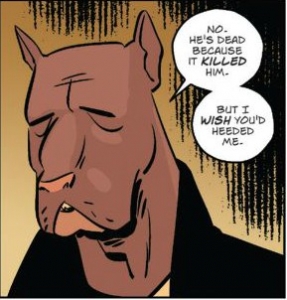 To start with the characters, Abnett does a phenomenal job from top to bottom. He casts his characters as animals that suit their personalities, as their physical appearances only help to heighten one’s reading experience. Your lead character of Clive Slipaway is a retired old war dog, whose years of service are clearly outlined on his face. He’s a dog who has seen his fair share of horrors, with the war having hollowed him instead of hardened him. With Clive you get a man who doesn’t recognize things like bravery or heroism, just the sheer visceral thought of survival and the toll it can take to achieve. Clive ends up being an almost tragic character who veers into the territory of being a predictable survivor of war but shows the darker, unspoken side that you pick up through subtlety instead of blaring it in one’s face. In the case of Clive, it is truly better for him to say little, which in turn says a lot about him instead of it being the other way around.
To start with the characters, Abnett does a phenomenal job from top to bottom. He casts his characters as animals that suit their personalities, as their physical appearances only help to heighten one’s reading experience. Your lead character of Clive Slipaway is a retired old war dog, whose years of service are clearly outlined on his face. He’s a dog who has seen his fair share of horrors, with the war having hollowed him instead of hardened him. With Clive you get a man who doesn’t recognize things like bravery or heroism, just the sheer visceral thought of survival and the toll it can take to achieve. Clive ends up being an almost tragic character who veers into the territory of being a predictable survivor of war but shows the darker, unspoken side that you pick up through subtlety instead of blaring it in one’s face. In the case of Clive, it is truly better for him to say little, which in turn says a lot about him instead of it being the other way around.
Behind Clive stands characters like Fawkes the fox, Peter Minks the mink, Ms. Peardew the cat, Alpherd the pig, and Grant the rabbit. Again, each one of these characters and their personalities is further represented by the animal they are cast as, embodying some of your average characteristics you’d find in the animal. For example, Alpherd and Peter, who are a pig and mink respectively, both come off easily as cowardly characters, never so filled with fear that they’re struck into inaction but still scared enough that they can be seen as part of the annoying crux of the group. With characters like Fawkes and Ms. Peardew though, you get some surprising character traits that show you this isn’t a cookie-cutter style story where you can predict every beat that comes your way. Fawkes turns out to be a stand out amongst the cast as, although his mannerisms suggest he is sneaky and untrustworthy, he is also brave and steps into action whenever needed. Ms.Peardew is a nervous wreck, suffering from agoraphobia, which makes her an almost jittery and unstable character. Abnett characterizes this through her constant need for a cigarette in the face of danger, a trend she appears incapable of bucking even during the downbeat moments of the story. Yet, she is still portrayed as intelligent, showing that even behind her diagnosed fear, she can be a strong character that stands out on her own and not even when she is necessarily needed to. It’s not even a stretch to say that she is the most intelligent of the characters, hammering home the fact that just because you suffer from an “illness” doesn’t necessarily mean that you’re weak.
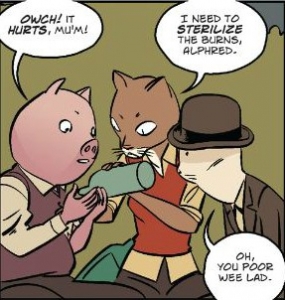 The next part of this comic wherein Abnett succeeds is his story, having already been stated as being appropriate for both children and adults. Let’s get this out of the way now though parents, there are characters who perish in the pages of this comic but this feeds into the reason why I state this comic is appropriate for children as any character death is never morbid or gratuitous, with Abnett and the artist I.N.J. Culbard going to great lengths to making the style of this book accessible for all. Scenes are tense, dramatic, saddening, and surprising with no degrees of inappropriate language or sexual content. The worst thing you’ll see a character do is consume alcohol but even then it feels like it’s done in a tasteful way that suits the character. In all honesty, this is the type of story that might make you or your children sad if you read it to them simply because of how attached Abnett makes you to these characters and then what he does in return to some of them. Going into the second issue there was a moment that I never would have predicted could happen and it’s these sort of things that keep you on your toes as a reader and make you want to keep reading. The idea to make this an anthropomorphic story with sci-fi elements is a simple but brilliant touch as it actually makes you invest more in these animal character than you might have been able if these characters were humans instead. Just think of it this way: how would you feel if this was your cat or dog in this story fighting for survival from an alien presence that could light them on fire? Yeah, you can remove your heart from your throat now.
The next part of this comic wherein Abnett succeeds is his story, having already been stated as being appropriate for both children and adults. Let’s get this out of the way now though parents, there are characters who perish in the pages of this comic but this feeds into the reason why I state this comic is appropriate for children as any character death is never morbid or gratuitous, with Abnett and the artist I.N.J. Culbard going to great lengths to making the style of this book accessible for all. Scenes are tense, dramatic, saddening, and surprising with no degrees of inappropriate language or sexual content. The worst thing you’ll see a character do is consume alcohol but even then it feels like it’s done in a tasteful way that suits the character. In all honesty, this is the type of story that might make you or your children sad if you read it to them simply because of how attached Abnett makes you to these characters and then what he does in return to some of them. Going into the second issue there was a moment that I never would have predicted could happen and it’s these sort of things that keep you on your toes as a reader and make you want to keep reading. The idea to make this an anthropomorphic story with sci-fi elements is a simple but brilliant touch as it actually makes you invest more in these animal character than you might have been able if these characters were humans instead. Just think of it this way: how would you feel if this was your cat or dog in this story fighting for survival from an alien presence that could light them on fire? Yeah, you can remove your heart from your throat now.
One of the defining pieces to this well orchestrated puzzle has to be Abnett’s use of dialogue. Casting the story in the 1930’s is going to drastically change the way characters use language now versus language from back then. The difference between the two types of language is night and day in a lot of regards, with our culture relying far more heavily on slang terms than what you’d see in the ’30’s. Abnett then takes it a step further by also having the story take place along the English countryside, where there are worlds that your average American English speaker won’t even know, let alone understand. It’s a bold choice that Abnett goes all-in on and it works to a marvellous degree as it immerses you deeply into this story about characters you fall in love with. That’s not to say there are no common words that we’d understand, as there are plenty of common phrases we use everyday in this story. It’s just fantastic to see these characters talk like they’re on an English countryside in the 1930’s instead of Manhattan in 2015.
Collects: Wild’s End #1-6.
Best Character: Fawkes.
Best Line Of Dialogue/Caption: “Revenge has no place in a man’s life. And as for courage—courage, heroism—they’re not simple values, Alph. Put them out of your head.” – Clive Slipaway.
Best Scene/Moment: Caught in the cornfield – Issue 4.
Best Issue: Issue 4 – Upper Deeping. Issue 4 opens in lightning fast fashion and shows you a lot of important details about all the characters present in the cornfield. It’s one of the larger action set pieces up to that point in the story and it’s one you’re sure to remember. From there, Abnett slows down the issue to give some emotional resonance to a discovery the group makes only to then rip the carpet out from underneath them in the final few moments of the issue.
Why You Should Read It: Wild’s End is an intelligent piece of literature that will make you forget it’s a comic book for a moment or two. The character work is excellent, the dialogue is perfect, the story is compelling and interesting, and if that isn’t enough to sell you, it’s appropriate for readers of almost all-ages. Abnett shows why he’s one of the best in the comic industry with a brilliantly simple premise of “animals + aliens + 1930’s English countryside = awesome”. Don’t even get me started on all the wonderful back matter at the conclusion of each issue as they are fantastic inclusions by Abnett and Culbard. If you don’t plan on picking up Wild’s End and reading it, I briskly shake my head at you in disappointment.
Guardians Of The Galaxy Ultimate Collection Vol 1
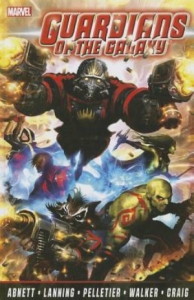 Dan Abnett and longtime co-writer, Andy Lanning, were key figureheads for revitalizing the cosmic Marvel line of comics back in the mid-2000s. Signing an exclusive contract in 2008, the two writers got to work on improving the cosmic tapestry by crafting the cosmic crossover, War Of Kings, followed by Realm Of Kings before completing their story in The Thanos Imperative. The work the two writers are perhaps most well-known for during this time period is their ongoing series for Nova and Guardians Of The Galaxy, elevating the characters associated in the two series to new levels of popularity. Now, years removed, the two writers no longer work together due to creative differences but their work together helped to influence the recent Guardians Of The Galaxy film that was released to widespread
Dan Abnett and longtime co-writer, Andy Lanning, were key figureheads for revitalizing the cosmic Marvel line of comics back in the mid-2000s. Signing an exclusive contract in 2008, the two writers got to work on improving the cosmic tapestry by crafting the cosmic crossover, War Of Kings, followed by Realm Of Kings before completing their story in The Thanos Imperative. The work the two writers are perhaps most well-known for during this time period is their ongoing series for Nova and Guardians Of The Galaxy, elevating the characters associated in the two series to new levels of popularity. Now, years removed, the two writers no longer work together due to creative differences but their work together helped to influence the recent Guardians Of The Galaxy film that was released to widespread
Following two near successive annihilation level events in outer space, the Marvel Universe has been left unstable with the constant fear of more potentially destructive moments coming its way. Peter Quill, also known as Star Lord, sets out to assemble an ace team of heroes who would attempt to circumvent any future incidences by retroactively dealing with them before they ever have the chance to evolve into anything near a detrimental level. Bringing together Drax the Destroyer, Gamora, Adam Warlock, Quasar, Rocket Raccoon, Groot, and Mantis, this unlikely band of misfits form the Guardians Of The Galaxy, set in their ways to protect the galaxy in any way, shape, or form that they can muster up. The Guardians face an immediate threat to not only the galaxy’s safety but their own as well on their first day on the job when they take on the Universal Church of Truth, a group of radical religious beings who seek to accelerate the end of the universe. There appears to be no down time for the team though as when they aren’t dealing with the Universal Church, they’re trying to figure out why time displaced heroes are in their timeline, how the skrulls have suddenly infiltrated their base on of operations on Knowhere, or if there is any way to stop King Balstaar in the Negative Zone from invading their dimension. Yup, they’ve got their work cut out for them but in their books, they wouldn’t have it any other way.
Dan Abnett and Andy Lanning help to give the cosmic side of the Marvel Universe the shot in the arm it deserves with their run on Guardians Of The Galaxy, with all of it starting in the pages of this recently re-released collected edition. Abnett and Lanning (or as their fans refer to them, DnA) show why cosmic comics can be equally fun as well as terrifying through their use of inventive characters, awe-inspiring settings, and intricate plots. To put it bluntly, this is not your average superhero team based comic book and that’s why it largely succeeds with what it tries to accomplish, throwing together a ragtag groups of heroes who definitely don’t belong together as the first line of defence against galactic level threats. The Guardians are assembled together to be the team that beats the bad guys to the punch, hoping to stop any future conflict dead in its tracks before it even gets a chance to get off the ground running.
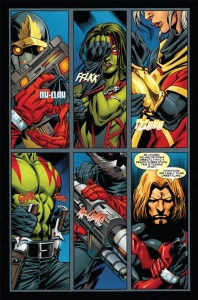 This story wouldn’t be the same without the roster Abnett and Lanning assembled for this new-age Guardians Of The Galaxy team. The team consists largely of the same characters seen in the recent blockbuster Guardians Of The Galaxy film, with that film actually drawing inspiration from this story. Peter Quill (a.k.a. Star-Lord) leads the team as the slightly over-confident but wildly brave leader, who has a tinge of scoundrel in him but still easily draws comparison to Harrison Ford portrayed characters like Indian Jones or Han Solo. He’s the perfect type of guy who you just can’t help but love, regardless of the awful decisions he may make. Behind him stands the characters of Quasar, Adam Warlock, Drax The Destroyer, Gamora, Rocket Raccoon, and Groot, with each character bringing a much-needed element to the team that, without them, the team just wouldn’t work or be the same. Quasar and Adam Warlock are your typical mystical/cosmic style characters who have powers that are easier explained once seen. You get your physical elements of the team from characters like Gamora and Drax who are highly trained and efficient killers who don’t lack a sense of humour. They flip from comedic to serious in the bat of an eye, buckling down and doing what needs to be done to ensure no one gets hurt or that the mission is successful. Groot is a character who falls into a similar role as Drax or Gamora, being a serious heavy hitter but spends much of this volume in the background as he’s “in recovery” (you’ll get it when you read it) and is a character whose dialogue only consists of three words, one of which is his name. It’s when you get to the character of Rocket Raccoon that you see the heart and soul of the team. Rocket has a brilliant strategic mind, a quick trigger finger, and a heart bigger than anyone else in the story. His comedic timing is impeccable and brings so much levity to the heavier scenes throughout the story. He’s a character who is balanced out brilliantly throughout the entire story, serving as someone who can both raise or alleviate the tension that’s built into a scene, which is something that, as a reader, you find immediately endearing. Beyond your core cast members, characters like Bug, Mantis, Major Victory, Cosmo and many more just show you what a brilliant cast Abnett and Lanning have formed to maximize your reading experience.
This story wouldn’t be the same without the roster Abnett and Lanning assembled for this new-age Guardians Of The Galaxy team. The team consists largely of the same characters seen in the recent blockbuster Guardians Of The Galaxy film, with that film actually drawing inspiration from this story. Peter Quill (a.k.a. Star-Lord) leads the team as the slightly over-confident but wildly brave leader, who has a tinge of scoundrel in him but still easily draws comparison to Harrison Ford portrayed characters like Indian Jones or Han Solo. He’s the perfect type of guy who you just can’t help but love, regardless of the awful decisions he may make. Behind him stands the characters of Quasar, Adam Warlock, Drax The Destroyer, Gamora, Rocket Raccoon, and Groot, with each character bringing a much-needed element to the team that, without them, the team just wouldn’t work or be the same. Quasar and Adam Warlock are your typical mystical/cosmic style characters who have powers that are easier explained once seen. You get your physical elements of the team from characters like Gamora and Drax who are highly trained and efficient killers who don’t lack a sense of humour. They flip from comedic to serious in the bat of an eye, buckling down and doing what needs to be done to ensure no one gets hurt or that the mission is successful. Groot is a character who falls into a similar role as Drax or Gamora, being a serious heavy hitter but spends much of this volume in the background as he’s “in recovery” (you’ll get it when you read it) and is a character whose dialogue only consists of three words, one of which is his name. It’s when you get to the character of Rocket Raccoon that you see the heart and soul of the team. Rocket has a brilliant strategic mind, a quick trigger finger, and a heart bigger than anyone else in the story. His comedic timing is impeccable and brings so much levity to the heavier scenes throughout the story. He’s a character who is balanced out brilliantly throughout the entire story, serving as someone who can both raise or alleviate the tension that’s built into a scene, which is something that, as a reader, you find immediately endearing. Beyond your core cast members, characters like Bug, Mantis, Major Victory, Cosmo and many more just show you what a brilliant cast Abnett and Lanning have formed to maximize your reading experience.
Part of the reason the roster feels so strong for this title isn’t just because they selected perfectly awesome characters, it’s because by the end of this first volume you feel as though the team dynamic is something these characters have had to fight to earn. Through these first twelve issues you see characters and their relationships develop and evolve in ways that completely change the trajectory of the story. By the midway mark of this series, the nature of the team for the first six issues is entirely thrown out the window and forced to begin a stage of rebuilding from there. It should be kept in mind how unlikely of allies this team appears to be, which ultimately strengthens and weakens the core dynamic between many of these characters as you watch conflicts arise between characters like Quill and Warlock, Quill and Rocket, or Drax and everyone. This is a group of individuals learning to be a team and, as a result, becoming better and worse people all in one motion. How the core cast even interacts with secondary players like Major Victory, Mantis, or Cosmo is constantly evolving and paying off as a reader. No matter where you look there is consistent progress, whether it be positive or negative, all across the first twelve issues of this series with this surprising large and rich cast of characters.
Enough about the characters though, let’s move along to the plot, which is ridiculously fun and welcoming to readers new or old. The essential premise is that following back-to-back “wars” in space, there feels as though there is a vacant power vacuum just waiting to be filled by the next “big bad” to strum on along. As a result, Peter Quill teams with Mantis to assemble a team that would retroactively defend the galaxy against any forthcoming invasions or assaults, hence the eventually name of the team “Guardians Of The Galaxy”. The team is quickly placed into conflict with the Universal Church of Truth, radical religious men and women who want to destroy the galaxy. From there the story spins out into what feels like a dozen different plot threads but never feels too overloaded with all the plates that it is handling. Every character feels like they serve a purpose to the plot because Abnett and Lanning give each character an objective or goal to reach. Quill and Mantis need to keep the team tight and focused on the tasks at hand while Adam is motivated to discover what the Church is actually up to. Drax is attempting to find purpose following the completion of his reason for existence, to kill Thanos, and works with Phyla-Vell (a.k.a. Quasar) to help move past the death of his daughter, Moon Dragon. Rocket and Groot just want to save the galaxy and stay out of trouble while keeping this band of misfits together. All of these plot motivations for these characters intersect and conflict with one another to always keep a heightened sense of drama that bleeds over to the secondary cast as well, seeing characters like Cosmo or Major Victory also dealing with their own character arcs and problems. This results in never getting the feeling that Abnett and Lanning are just spinning the same wheel over and over again, as they always push forward to some form of progress with this title, whether it be for the entire team or a single character.
There’s always plenty going on in the story but Abnett and Lanning do a great job of guiding the reader through the story, regardless of the multiple different perspectives that are present. They make a brilliant decision in terms of storytelling, setting the story slightly in the past and informing the reader of forthcoming events by having the cast reflect on the events you’re seeing unfold. The characters submit video logs to Mantis after every mission they go on for psychological evaluation, with clips of these video logs being displayed over the action that you’re seeing unfold, even though it’s already technically occurred. For example, there may be a huge firefight going on between the team and the Universal Church Of Truth with Rocket Raccoon making some form of joke. The next panel, Rocket is sitting in front of a camera recollecting what he said to then make a comment about how he nearly died five minutes after the joke he made, with the action cutting to that moment where he nearly died or something to that effect. It’s a clever little piece of writing by Abnett and Lanning as it completely eliminates the use of captions to show a characters silent thoughts, something that was a common way of telling stories decades ago but doesn’t really suit modern comics too neatly unless it’s in a Batman comic. In writing the story this way, we’re given personal insight to each character’s thoughts as events are unfolding to help inform the direction of the plot as well as give us a common style of narration, just done in a more modern way. In short, it’s brilliant with how simple but effectively it is executed. It’s a neat little element that you come to miss when it isn’t present in the story, but it’s also not overused to the point where you get sick of it as a plot device.
Collects: Guardians Of The Galaxy #1-12.
Best Character: Rocket Raccoon or Cosmo. Seriously, take your pick because they’re both awesome.
Best Line Of Dialogue/Caption: “In twenty four hours’ time, the team will agree on “The Guardians Of The Galaxy.” It would be an abuse of my precognition to tell them this.” – Mantis.
Best Scene/Moment: The Guardians come together in the Negative Zone – Issue 10.
Best Issue: Issue 10 – Blastaared. I actually largely consider this a proper end point to this volume as the two issues that proceed after it are quite self-contained and follow the exploits of Drax and Phyla-Vell. This tenth issue ends off with the Guardians on a fairly heroic note, as it’s a silently defining moment for the team. There’s a fun, if underwhelming showdown in the Negative Zone, development on the Universal Church Of Truth front, some legitimately hilarious moments that truly define the tone and direction of this book, and to top it all off the unofficial epilogue of this comic gives you a chilling “S#!* about to get real” sense. This issue epitomizes everything Abnett and Lanning set out to do with this Guardians series, which is make cosmic comics fun AND serious.
Why You Should Read It: This is a high-caliber superhero team book. You’ll be hard sought to find a book that better develops not only the individual characters but the team as a whole in a more convincing way than Abnett and Lanning do here. Each character has a distinct voice and personality, brings something important to this team as well as the adventures they face. The plot itself does plenty of great things, with each arc having the team deal with different but fascinating scenarios. To an even further point, this book doesn’t behave in the way your typical team book does just based around the direction it heads in after what you’d consider your first two arcs in this collected edition. By the time you reach the end of issue six, the entire team dynamic that you’ve become surprisingly cozy with has suddenly changed in a way that still engages you. I can gush all day about this book as it falls within my favourite era of Marvel comics ever. Believe me when I say that from the Marvel cosmic event, Annihilation, all the way through to Thanos Imperative, the work that Dan Abnett, Andy, Lanning, and more do is stellar, with Guardians Of The Galaxy being a can’t miss piece to the beautiful space-faring tapestry they’ve created.

